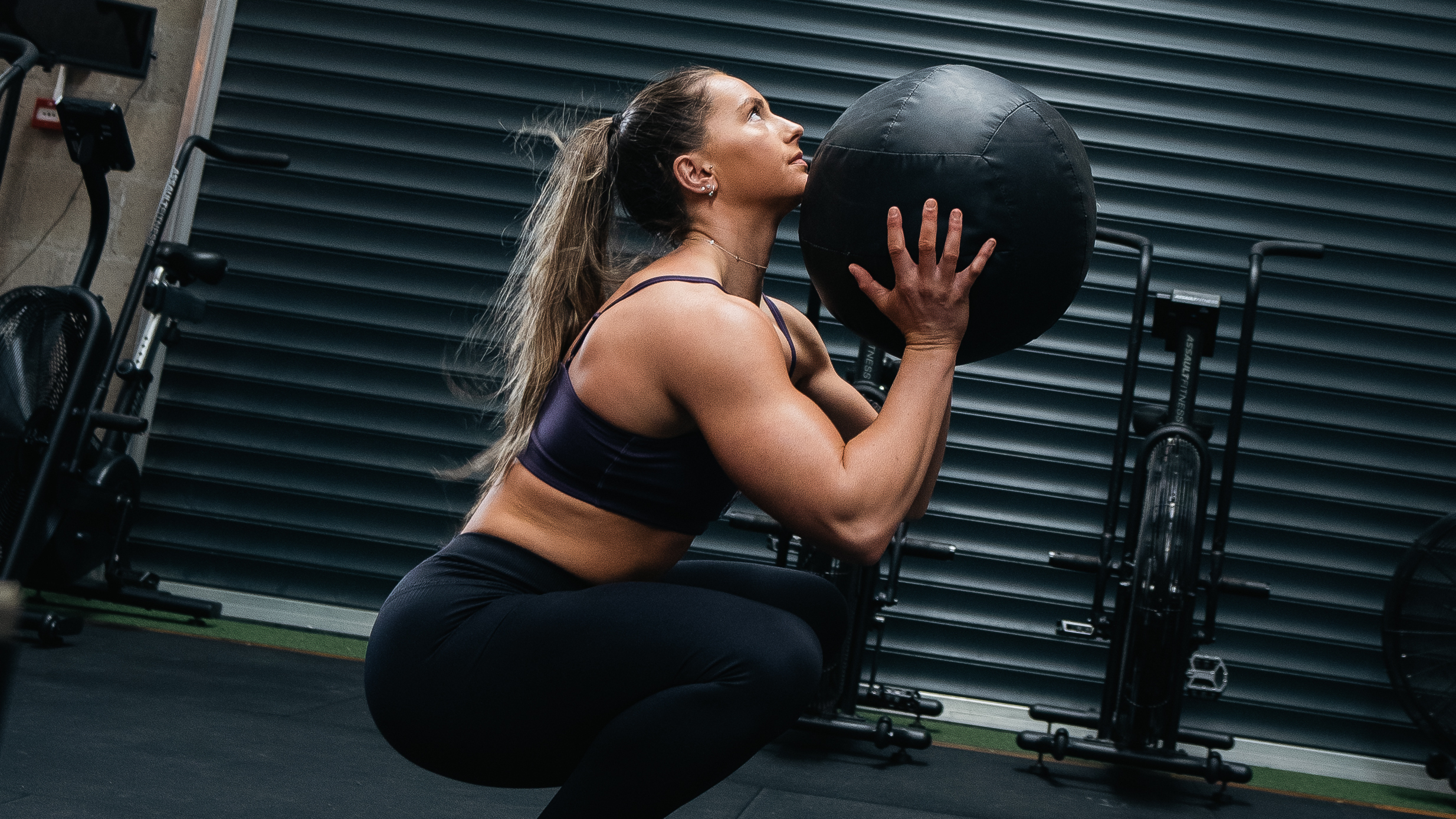If you’re looking to increase strength, sharpen your core, and challenge virtually every muscle, this movement is for you. The wall ball is a functional, whole-body exercise you can slot into strength or cardio sessions.
Though commonly seen in CrossFit workouts, the power and efficiency of this move have made it a staple in many gyms and training spaces.
Read on to discover the advantages of the wall ball, learn how to perform it safely, and explore variations that can elevate your training.

What is a wall ball exercise?
The wall ball is a compound, high-intensity movement that demands substantial effort from numerous muscle groups.
Also called a wall ball squat, the exercise blends a lower-body squat with an upper-body push-press as you launch a weighted ball toward a wall.
All you need is a clear, vertical surface and a weighted wall ball. The classic version has you facing the wall, though alternative forms alter your orientation to target different muscles.
What type of ball should you use?
A wall ball is distinct from a medicine ball, which is smaller, firmer, and not intended for wall throws. It’s also different from a slam ball, which is heavier, usually rubber, and designed for ground slams.
Picking the proper ball improves performance and reduces injury risk. For repeated reps, a ball made specifically for wall throws is ideal.
Wall balls are generally vinyl with a cushioned outer surface to make catching easier. They come in weights from roughly 6 to 20 pounds.
When selecting weight, consider your core and upper-body strength. The ball should be challenging without forcing you to sacrifice form.
In practice, begin with a lighter ball and progress to heavier increments as your technique improves. Novices might use 6–8 pounds, while more experienced athletes may opt for 10 pounds or more.
What are the benefits of wall ball?
Wall balls deliver a broad range of benefits and engage nearly every major muscle group. They also move your body through multiple planes — forward-back, side-to-side, and rotationally.
A standard wall ball rep activates several muscle groups, including:
- quadriceps
- glutes
- hamstrings
- back
- chest
- shoulders
- biceps
- triceps
- core muscles
This exercise elevates heart rate, making it effective for boosting cardiorespiratory fitness and burning calories. It also develops explosive power, which is important for many sports.
Additionally, wall balls can refine hand-eye coordination and enhance throwing accuracy.
How is a typical wall ball exercise done?
- Pick an appropriately weighted wall ball and hold it securely.
- Stand about 2 feet from the wall with feet hip-width apart and toes slightly turned out.
- Cradle the ball at chest level, keeping your elbows tucked in.
- Engage your core and squeeze the ball — the firmer the squeeze, the more your core and shoulders work.
- Descend into a squat while maintaining the ball at chest height. Lower until your thighs are roughly parallel to the floor.
- Explosively stand up and throw the ball at a vertical target about 8–12 feet high, extending your arms. Tip: pick a point on the target to focus on for consistent accuracy.
- Catch the ball as it returns, reset it at chest height, and descend into the next squat.
- Perform 10–15 reps for 2–3 sets, or set a 30-second timer and complete as many reps as possible.
Wall ball variations
Side throws
This version turns your torso for a rotational pattern that taxes the obliques, as well as the chest and shoulders.
- Grip the ball with palms up.
- Stand perpendicular to the wall, right shoulder facing it, roughly 3 feet away.
- Lower into a squat with the ball positioned outside your left hip.
- As you rise, pivot the left foot, rotate your torso, and throw the ball at the wall.
- Remain in position to catch the rebound, return to the start, and repeat.
- Complete 10 reps per side.
If that’s too challenging, begin with standing trunk rotations: hold the ball at chest height and rotate your torso left and right.
Forward underhand toss
For a deeper squat that emphasizes the adductors, try the underhand forward toss. Pointing your toes outward recruits the inner thighs and increases glute involvement.
The underhand throw engages the biceps and chest as well.
- Face the wall as in the standard wall ball.
- Hold the ball, then position it between your legs.
- Adopt a wide squat stance.
- Drive through the glutes to stand and toss the ball upward toward the wall.
- Catch the ball and return to the squat start.
- Repeat 10 times.
Reverse rotations
This drill needs a strong core and ability to rotate bilaterally. Only attempt reverse rotations after mastering the basic wall ball, having strong obliques, and good upper-body mobility.
This pattern targets shoulders, upper back, biceps, chest, core, quads, hamstrings, and glutes.
- Hold the ball with palms up and stand with your back to the wall.
- Step back at least a body-length from the wall (for example, someone 6 feet tall should step about 6 feet away).
- Squat, rotate to the right, and toss the ball at the wall while looking over your right shoulder.
- Retrieve the ball after it rebounds and repeat on the opposite side.
- Perform 10 reps per side.
The bottom line
The wall ball is a moderate-to-advanced movement that pairs well with many workout formats and strength circuits.
Adding a few sets of wall balls can raise your heart rate, enhance cardiovascular capacity, and make your workouts more calorie-efficient while building strength across numerous muscle groups.
To further challenge yourself, explore the different variations or gradually increase the ball’s weight as your technique and strength improve.


















Leave a Reply
You must be logged in to post a comment.